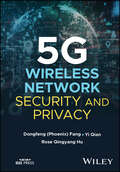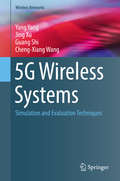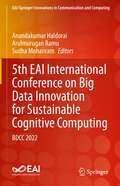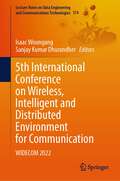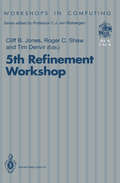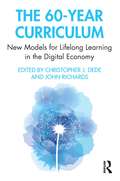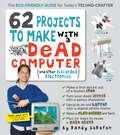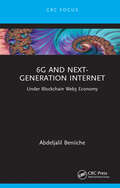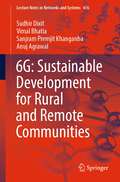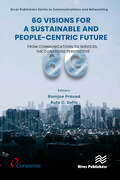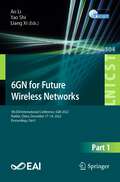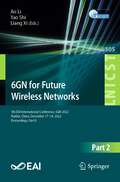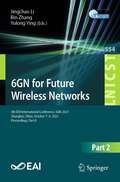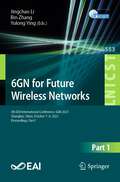- Table View
- List View
5G Wireless Network Security and Privacy (IEEE Press)
by DongFeng Fang Yi Qian Rose Qingyang Hu5G WIRELESS NETWORK An expert presentation of 5G security, privacy, and network performance In 5G Wireless Network Security and Privacy, a team of veteran engineers delivers a robust and accessible discussion of 5G security solutions, including physical layer security, authentication, and mobility management. In the book, the authors expertly cover the requirements of 5G wireless network security and privacy, with explorations of existing solutions and vulnerabilities from security architecture and mechanism perspectives. Readers will learn how to enhance the security and network performance of 5G wireless networks in contexts like vehicle‐to‐vehicle and vehicle‐to‐infrastructure communications, industrial automation, health services, smart cities, and smart homes. They will develop a comprehensive understanding of 5G wireless network security as they move through the book’s 11 insightful chapters, developing in‐depth knowledge on the current state of 5G security and coming developments in the field. Readers will also find: A thorough introduction to legacy cellular network security, including network performance development from 1G to 4G In‐depth treatments of 5G network security, including the motivation and objectives of 5G wireless network security Comprehensive explorations of wireless security solutions, including cryptographic approaches and physical layer security Fulsome discussions of the security architecture of cellular networks, including 3G and 4G security Perfect for researchers and professionals working in the field of cybersecurity and 5G wireless networks, 5G Wireless Network Security and Privacy will also earn a place in the libraries of engineers, computer scientists, and graduate students studying 5G network security and privacy.
5G Wireless Network Security and Privacy (IEEE Press)
by DongFeng Fang Yi Qian Rose Qingyang Hu5G WIRELESS NETWORK An expert presentation of 5G security, privacy, and network performance In 5G Wireless Network Security and Privacy, a team of veteran engineers delivers a robust and accessible discussion of 5G security solutions, including physical layer security, authentication, and mobility management. In the book, the authors expertly cover the requirements of 5G wireless network security and privacy, with explorations of existing solutions and vulnerabilities from security architecture and mechanism perspectives. Readers will learn how to enhance the security and network performance of 5G wireless networks in contexts like vehicle‐to‐vehicle and vehicle‐to‐infrastructure communications, industrial automation, health services, smart cities, and smart homes. They will develop a comprehensive understanding of 5G wireless network security as they move through the book’s 11 insightful chapters, developing in‐depth knowledge on the current state of 5G security and coming developments in the field. Readers will also find: A thorough introduction to legacy cellular network security, including network performance development from 1G to 4G In‐depth treatments of 5G network security, including the motivation and objectives of 5G wireless network security Comprehensive explorations of wireless security solutions, including cryptographic approaches and physical layer security Fulsome discussions of the security architecture of cellular networks, including 3G and 4G security Perfect for researchers and professionals working in the field of cybersecurity and 5G wireless networks, 5G Wireless Network Security and Privacy will also earn a place in the libraries of engineers, computer scientists, and graduate students studying 5G network security and privacy.
5G Wireless Systems: Simulation and Evaluation Techniques (Wireless Networks)
by Yang Yang Jing Xu Guang Shi Cheng-Xiang WangThis book focuses on key simulation and evaluation technologies for 5G systems. Based on the most recent research results from academia and industry, it describes the evaluation methodologies in depth for network and physical layer technologies. The evaluation methods are discussed in depth. It also covers the analysis of the 5G candidate technologies and the testing challenges, the evolution of the testing technologies, fading channel measurement and modeling, software simulations, software hardware cosimulation, field testing and other novel evaluation methods. The fifth-generation (5G) mobile communications system targets highly improved network performances in terms of the network capacity and the number of connections.Testing and evaluation technologies is widely recognized and plays important roles in the wireless technology developments, along with the research on basic theory and key technologies. The investigation and developments on the multi-level and comprehensive evaluations for 5G new technologies, provides important performance references for the 5G technology filtering and future standardizations. Students focused on telecommunications, electronic engineering, computer science or other related disciplines will find this book useful as a secondary text. Researchers and professionals working within these related fields will also find this book useful as a reference.
5th EAI International Conference on Big Data Innovation for Sustainable Cognitive Computing: BDCC 2022 (EAI/Springer Innovations in Communication and Computing)
by Anandakumar Haldorai Arulmurugan Ramu Sudha MohanramThis book features the proceedings of the 5th EAI International Conference on Big Data Innovation for Sustainable Cognitive Computing (BDCC 2022). The papers feature detail on cognitive computing and its self-learning systems that use data mining, pattern recognition and natural language processing (NLP) to mirror the way the human brain works. This international conference focuses on technologies from knowledge representation techniques and natural language processing algorithms to dynamic learning approaches. Topics covered include Data Science for Cognitive Analysis, Real-Time Ubiquitous Data Science, Platform for Privacy Preserving Data Science, and Internet-Based Cognitive Platform.
5th International Conference on Practical Applications of Computational Biology & Bioinformatics (Advances in Intelligent and Soft Computing #93)
by Juan Manuel Corchado Rodríguez Florentino Fdez Riverola Alfonso Valencia Miguel P. RochaThe growth in the Bioinformatics and Computational Biology fields over the last few years has been remarkable and the trend is to increase its pace. In fact, the need for computational techniques that can efficiently handle the huge amounts of data produced by the new experimental techniques in Biology is still increasing driven by new advances in Next Generation Sequencing, several types of the so called omics data and image acquisition, just to name a few. The analysis of the datasets that produces and its integration call for new algorithms and approaches from fields such as Databases, Statistics, Data Mining, Machine Learning, Optimization, Computer Science and Artificial Intelligence. Within this scenario of increasing data availability, Systems Biology has also been emerging as an alternative to the reductionist view that dominated biological research in the last decades. Indeed, Biology is more and more a science of information requiring tools from the computational sciences. In the last few years, we have seen the surge of a new generation of interdisciplinary scientists that have a strong background in the biological and computational sciences. In this context, the interaction of researchers from different scientific fields is, more than ever, of foremost importance boosting the research efforts in the field and contributing to the education of a new generation of Bioinformatics scientists. PACBB‘11 hopes to contribute to this effort promoting this fruitful interaction. PACBB'11 technical program included 50 papers from a submission pool of 78 papers spanning many different sub-fields in Bioinformatics and Computational Biology. Therefore, the conference will certainly have promoted the interaction of scientists from diverse research groups and with a distinct background (computer scientists, mathematicians, biologists). The scientific content will certainly be challenging and will promote the improvement of the work that is being developed by each of the participants.
5th International Conference on Wireless, Intelligent and Distributed Environment for Communication: WIDECOM 2022 (Lecture Notes on Data Engineering and Communications Technologies #174)
by Isaac Woungang Sanjay Kumar DhurandherThis book presents the proceedings of the 5th International Conference on Wireless Intelligent and Distributed Environment for Communication (WIDECOM 2022), which took place at the University of Windsor, Windsor, Canada, October 12-14, 2022. The book addresses issues related to new dependability paradigms, design, and performance of dependable network computing and mobile systems, as well as issues related to the security of these systems. The goal of the conference is to provide a forum for researchers, students, scientists and engineers working in academia and industry to share their experiences, new ideas and research results in the above-mentioned areas.
5th International Symposium on Data Mining Applications (Advances in Intelligent Systems and Computing #753)
by Mamdouh Alenezi Basit QureshiThe 5th Symposium on Data Mining Applications (SDMA 2018) provides valuable opportunities for technical collaboration among data mining and machine learning researchers in Saudi Arabia, Gulf Cooperation Council (GCC) countries and the Middle East region. This book gathers the proceedings of the SDMA 2018. All papers were peer-reviewed based on a strict policy concerning the originality, significance to the area, scientific vigor and quality of the contribution, and address the following research areas.• Applications: Applications of data mining in domains including databases, social networks, web, bioinformatics, finance, healthcare, and security.• Algorithms: Data mining and machine learning foundations, algorithms, models, and theory.• Text Mining: Semantic analysis and mining text in Arabic, semi-structured, streaming, multimedia data.• Framework: Data mining frameworks, platforms and systems implementation.• Visualizations: Data visualization and modeling.
5th Refinement Workshop: Proceedings of the 5th Refinement Workshop, organised by BCS-FACS, London, 8–10 January 1992 (Workshops in Computing)
by Cliff Jones Roger C. Shaw Tim DenvirRefinement is the term used to describe systematic and formal methods of specifying hard- and software and transforming the specifications into designs and implementations. The value of formal methods in producing reliable hard- and software is widely appreciated by academics and workers in industry, despite the fact that certain research areas, such as the application to industrial-scale problems, are still in their infancy. This volume contains the papers presented at the 5th Refinement Workshop held in London, 8-10 January 1992. Its theme was the theory and practice of software specifications, which is the transformation of formal software specifications into more correct specifications, designs and codes. This has been an important area of research for the last 5 years and the workshop addressed specific issues and problems related to it. Among the topics discussed in this volume are: the role of refinement in software development, parallel designs and implementations, methods and tools for verification of critical properties, refinement and confidentiality, concurrent processes as objects, the compliance of Ada programs with Z specifications and a tactic driven refinement tool. This is the latest refinement workshop proceedings to be published in the Workshops in Computing series (the 3rd and 4th workshops having appeared in 1990 and 1991 respectively). It will be of interest to academic and industrial researchers, postgraduate students and research-oriented developers in the computer industry.
The 60-Year Curriculum: New Models for Lifelong Learning in the Digital Economy
by Christopher J. DedeThe 60-Year Curriculum explores models and strategies for lifelong learning in an era of profound economic disruption and reinvention. Over the next half-century, globalization, regional threats to sustainability, climate change, and technologies such as artificial intelligence and data mining will transform our education and workforce sectors. In turn, higher education must shift to offer every student life-wide opportunities for the continuous upskilling they will need to achieve decades of worthwhile employability. This cutting-edge book describes the evolution of new models—covering computer science, inclusive design, critical thinking, civics, and more—by which universities can increase learners’ trajectories across multiple careers from mid-adolescence to retirement. Stakeholders in workforce development, curriculum and instructional design, lifelong learning, and higher and continuing education will find a unique synthesis offering valuable insights and actionable next steps.
The 60-Year Curriculum: New Models for Lifelong Learning in the Digital Economy
by Christopher J. Dede John RichardsThe 60-Year Curriculum explores models and strategies for lifelong learning in an era of profound economic disruption and reinvention. Over the next half-century, globalization, regional threats to sustainability, climate change, and technologies such as artificial intelligence and data mining will transform our education and workforce sectors. In turn, higher education must shift to offer every student life-wide opportunities for the continuous upskilling they will need to achieve decades of worthwhile employability. This cutting-edge book describes the evolution of new models—covering computer science, inclusive design, critical thinking, civics, and more—by which universities can increase learners’ trajectories across multiple careers from mid-adolescence to retirement. Stakeholders in workforce development, curriculum and instructional design, lifelong learning, and higher and continuing education will find a unique synthesis offering valuable insights and actionable next steps.
6183_CCNA Routing and Switching 200-125 Certification Guide: The Ultimate Solution For Passing The Ccna Certification And Boosting Your Networking Career
by Lazaro Laz DiazCisco Certified Network Associate (CCNA) Routing and Switching is one of the most important certificates in order to stay up-to-date with networking skills. This Certification Guide covers everything you need to know in order to pass the CCNA Routing and Switching 200-125.
62 Projects to Make with a Dead Computer: (And Other Discarded Electronics)
by Randy SarafanComputer hacking takes on a whole new meaning when you're going at it with a screwdriver and hammer: announcing the most wildly inventive, eco-friendly craft book on repurposing everyday objects since Generation T. Except in this case the raw material isn't a T-shirt, but the stuff we all have lying around and have no idea what to do with, or even how to get rid of properly—your old cell phone, a broken printer, irredeemable iPod, busted digital camera, mysterious thatches of cables and wires, orphaned keyboards, and of course, those dead PCs and laptops. Created by a Parsons design graduate who’s obsessed with navigating the intersection of art and technology, here are 62 ingenious projects that are irresistibly geek-chic. An iMac Terrarium—how cool is that? A laptop Digital Photo Frame. The impressively green Scanner Compost Bin. Plus a power strip Bird Feeder, Walkman Soap Dish, My First Squiggle Bot, Qwerty Hair Tie, Flat-screen Ant Farm. Each project has complete, step-by-step instructions, is rated by difficulty—in a thorough first chapter the author covers all the tools and skills needed to take apart electronics safely—and is arranged by use, from stuff for the house, to fashion, toys, arts and crafts, items for pets, and more.
64 Geeks: The Brains Who Shaped Our World
by Chas Newkey-BurdenWe wouldn't have Bluetooth or Wi-Fi today without the ingenuity of an actress once described as "the most beautiful woman in the world."And we might have had mobile messaging as early as 1901, were it not for the fickleness of a banker. From celebrated prodigies and self-proclaimed geniuses to history's hidden heroes-64 GEEKS brings you the incredible stories of the world's best brains, all presented alongside clever 8-bit likenesses.
The 68000 Microprocessor
by Andrew M. VeronisThe Motorola MC68000 family of microprocessors is undoubtedly a revolu tionary set of devices. The MC68000 is the first advanced 16-bit microprocessor with a 32-bit internal architecture and the first with 16-megabyte, nonsegment ed, direct memory addressing. The processor's six basic addressing modes are equivalent to 14, when one considers all of the variations among these modes. Combined with the device's data and instruction types, the modes provide more than 1000 useful instructions. The book you are about to study has been developed as an aid to the hard ware designer and as a supplement to the Motorola seminars on the 68000 microprocessor. The text includes a detailed description of the MC68000 and two complete systems that show how this processor can be interfaced to the outside world. The book follows a "top-down" approach. A brief history of microprocessors is provided first. Chapter 2 details the MC68000 by describing its registers, control lines, and capabilities. Chapter 3 introduces a small MC68000-based system. Although this system is characterized in the book as hypothetical, it is indeed the Educational Computer Board, used in the various Motorola seminars. The addressing modes and instructions are explained in Chapter 4, which includes helpful hints on how instructions can be used. Chapter 5 provides an in-depth description of additional instructions and numerous examples. Chapter 6 discusses exception handling and interrupts.
6G and Next-Generation Internet: Under Blockchain Web3 Economy
by Abdeljalil BeniicheThe sixth generation (6G) of wireless cellular networks is expected to incorporate the latest developments in network infrastructure and emerging advances in technology. It will not only explore more spectrum at high-frequency bands but also converge driving technological trends, including connected robotics, artificial intelligence (AI), and blockchain technologies. There is also a strong notion that the nature of mobile terminals will change, whereby intelligent mobile robots are anticipated to play a more important role. Importantly, 6G will become more human-centered than 5G, which primarily focused on industry verticals. This book explores the human-centeredness of blockchain and Web3 economy for the 6G era. Aimed at graduate students, network and blockchain researchers, professionals, engineers, and practitioners, this book discusses the symbiosis of blockchain with other key technologies such as AI and robots, while putting the focus on the Tactile Internet for advanced human-to-machine interaction. By focusing on the research field of robonomics in the 6G Era, which studies the social integration of robots into the economy and human society, the book puts the various developed ideas and concepts into the perspective of the future Super Smart Society 5.0.
6G and Next-Generation Internet: Under Blockchain Web3 Economy
by Abdeljalil BeniicheThe sixth generation (6G) of wireless cellular networks is expected to incorporate the latest developments in network infrastructure and emerging advances in technology. It will not only explore more spectrum at high-frequency bands but also converge driving technological trends, including connected robotics, artificial intelligence (AI), and blockchain technologies. There is also a strong notion that the nature of mobile terminals will change, whereby intelligent mobile robots are anticipated to play a more important role. Importantly, 6G will become more human-centered than 5G, which primarily focused on industry verticals. This book explores the human-centeredness of blockchain and Web3 economy for the 6G era. Aimed at graduate students, network and blockchain researchers, professionals, engineers, and practitioners, this book discusses the symbiosis of blockchain with other key technologies such as AI and robots, while putting the focus on the Tactile Internet for advanced human-to-machine interaction. By focusing on the research field of robonomics in the 6G Era, which studies the social integration of robots into the economy and human society, the book puts the various developed ideas and concepts into the perspective of the future Super Smart Society 5.0.
6G Enabled Fog Computing in IoT: Applications and Opportunities
by Mohit Kumar Sukhpal Singh Gill Jitendra Kumar Samriya Steve UhligOver the past few years, the demand for data traffic has experienced explosive growth thanks to the increasing need to stay online. New applications of communications, such as wearable devices, autonomous systems, drones, and the Internet of Things (IoT), continue to emerge and generate even more data traffic with vastly different performance requirements. With the COVID-19 pandemic, the need to stay online has become even more crucial, as most of the fields, would they be industrial, educational, economic, or service-oriented, had to go online as best as they can. As the data traffic is expected to continuously strain the capacity of future communication networks, these networks need to evolve consistently in order to keep up with the growth of data traffic. Thus, more intelligent processing, operation, and optimization will be needed for tomorrow’s communication networks. The Sixth Generation (6G) technology is latest approach for mobile systems or edge devices in terms of reduce traffic congestions, energy consumption blending with IoT devices applications. The 6G network works beyond the 5G (B5G), where we can use various platforms as an application e.g. fog computing enabled IoT networks, Intelligent techniques for SDN network, 6G enabled healthcare industry, energy aware location management. Still this technology must resolve few challenges like security, IoT enabled trust network.This book will focus on the use of AI/ML-based techniques to solve issues related to 6G enabled networks, their layers, as well as their applications. It will be a collection of original contributions regarding state-of-the-art AI/ML-based solutions for signal detection, channel modeling, resource optimization, routing protocol design, transport layer optimization, user/application behavior prediction 6G enabled software-defined networking, congestion control, communication network optimization, security, and anomaly detection. The proposed edited book emphasis on the 6G network blended with Fog-IoT networks to introduce its applications and future perspectives that helps the researcher to apply this technique in their domain and it may also helpful to resolve the challenges and future opportunities with 6G networks.
6G Mobile Wireless Networks (Computer Communications and Networks)
by Yulei Wu Abhishek Roy Sukhdeep Singh Tarik Taleb Harpreet S. Dhillon Madhan Raj Kanagarathinam Aloknath DeThis book is the world’s first book on 6G Mobile Wireless Networks that aims to provide a comprehensive understanding of key drivers, use cases, research requirements, challenges and open issues that are expected to drive 6G research. In this book, we have invited world-renowned experts from industry and academia to share their thoughts on different aspects of 6G research. Specifically, this book covers the following topics: 6G Use Cases, Requirements, Metrics and Enabling Technologies, PHY Technologies for 6G Wireless, Reconfigurable Intelligent Surface for 6G Wireless Networks, Millimeter-wave and Terahertz Spectrum for 6G Wireless, Challenges in Transport Layer for Tbit/s Communications, High-capacity Backhaul Connectivity for 6G Wireless, Cloud Native Approach for 6G Wireless Networks, Machine Type Communications in 6G, Edge Intelligence and Pervasive AI in 6G, Blockchain: Foundations and Role in 6G, Role of Open-source Platforms in 6G, and Quantum Computing and 6G Wireless. The overarching aim of this book is to explore the evolution from current 5G networks towards the future 6G networks from a service, air interface and network perspective, thereby laying out a vision for 6G networks. This book not only discusses the potential 6G use cases, requirements, metrics and enabling technologies, but also discusses the emerging technologies and topics such as 6G PHY technologies, reconfigurable intelligent surface, millimeter-wave and THz communications, visible light communications, transport layer for Tbit/s communications, high-capacity backhaul connectivity, cloud native approach, machine-type communications, edge intelligence and pervasive AI, network security and blockchain, and the role of open-source platform in 6G. This book provides a systematic treatment of the state-of-the-art in these emerging topics and their role in supporting a wide variety of verticals in the future. As such, it provides a comprehensive overview of the expected applications of 6G with a detailed discussion of their requirements and possible enabling technologies. This book also outlines the possible challenges and research directions to facilitate the future research and development of 6G mobile wireless networks.
6G: Sustainable Development for Rural and Remote Communities (Lecture Notes in Networks and Systems #416)
by Sudhir Dixit Vimal Bhatia Sanjram Premjit Khanganba Anuj AgrawalThe book covers a variety of feasible technology options, both wired and wireless, to enable 6G connectivity in rural and remote regions. Along with the enabling technology options, the book also covers important aspects such as human-computer interaction, business models for the local operator ecosystem, regulatory and right-of-way policies, security and privacy, and future challenges related to technology migration, urbanization, and scalability. A special feature of this book is that it covers both the optical and wireless technology aspects to realize 6G connectivity, which will be of interest to a broad range of researchers and practitioners. Detailed figures have been included in the book to cover both the fiber-optics and wireless aspects. These figures include telecommunication equipment and networks ranging from a locality to the under-sea cables to high latitude platforms. The book has simple explanations, pictorial representations, minimal math, and conversational language, which will enable all the readers to grasp it, thereby helping them in decision making and performing comprehensive analysis. This book includes the needs of the unconnected and under-connected sections of the society, notably from the rural and remote areas, when the 6G standards are being discussed and developed. This feature will help overcome the challenge of widening the digital divide from every new generation of mobile network standards. Hence, the book covers all technical and non-technical aspects to be of interest to researchers, decision-makers, academia, social workers, and the readers in technology, growth, and empowerment.
6G Visions for a Sustainable and People-centric Future: From Communications to Services, the CONASENSE Perspective (River Publishers Series in Communications and Networking)
by Ramjee Prasad Rute C. Sofia6G is currently under definition, being often addressed from a plain telecommunications perspective as an evolutionary paradigm that represents an extension of 5G. Having as a horizon 2030, 6G initiatives are being deployed across the globe to further ignite the development of 6G services. At its philosophical core, 6G embodies the "human in the loop" principle. The research effort being developed towards 6G requires an interdisciplinary approach that ignites discussion across different key technological sectors, ranging from communications up to services and business cases. The contributions of this book to research in the field concern an evolutionary and interdisciplinary design of 6G as a paradigm that can be addressed by working together four different computational areas: communications; satellites and navigation; sensing; services. The book is derived from initial brainstorming that was developed during the 11th CONASENSE Symposium held in October 2021 in fortiss, Munich, Germany. Several international experts contribute to an overview of 6G key challenges, new networking trends and challenges to be overcome, and advanced 6G services. The book starts with a perspective on 6G challenges and use-cases beyond the 2030 horizon, to then continue to address the role of non-terrestrial networks and cognitive, service-centric satellite networks in future 6G services. Still with focus on 6G adaptive networking, the book continues with a debate on the need to integrate social awareness based on an interdisciplinary approach in network operations. Then, specific examples of advanced services (quantum imaging and holography; localization of the Internet of remote things) are discussed. The book is, therefore, intended to assist in developing critical thinking to back up novel networking, applications, and services towards 6G.
6G Visions for a Sustainable and People-centric Future: From Communications to Services, the CONASENSE Perspective (River Publishers Series in Communications and Networking)
by Ramjee Prasad Rute C. Sofia6G is currently under definition, being often addressed from a plain telecommunications perspective as an evolutionary paradigm that represents an extension of 5G. Having as a horizon 2030, 6G initiatives are being deployed across the globe to further ignite the development of 6G services. At its philosophical core, 6G embodies the "human in the loop" principle. The research effort being developed towards 6G requires an interdisciplinary approach that ignites discussion across different key technological sectors, ranging from communications up to services and business cases. The contributions of this book to research in the field concern an evolutionary and interdisciplinary design of 6G as a paradigm that can be addressed by working together four different computational areas: communications; satellites and navigation; sensing; services. The book is derived from initial brainstorming that was developed during the 11th CONASENSE Symposium held in October 2021 in fortiss, Munich, Germany. Several international experts contribute to an overview of 6G key challenges, new networking trends and challenges to be overcome, and advanced 6G services. The book starts with a perspective on 6G challenges and use-cases beyond the 2030 horizon, to then continue to address the role of non-terrestrial networks and cognitive, service-centric satellite networks in future 6G services. Still with focus on 6G adaptive networking, the book continues with a debate on the need to integrate social awareness based on an interdisciplinary approach in network operations. Then, specific examples of advanced services (quantum imaging and holography; localization of the Internet of remote things) are discussed. The book is, therefore, intended to assist in developing critical thinking to back up novel networking, applications, and services towards 6G.
6GN for Future Wireless Networks: 5th EAI International Conference, 6GN 2022, Harbin, China, December 17-18, 2022, Proceedings, Part I (Lecture Notes of the Institute for Computer Sciences, Social Informatics and Telecommunications Engineering #504)
by Ao Li Yao Shi Liang XiThis 2-volume set constitutes the proceedings of the 5th International Conference on 6G for Future Wireless Networks, 6GN 2022, held in Harbin, China, in December 2022. The 60 full papers were selected from 194 submissions and present the state of the art and practical applications of 6G technologies. The papers are arranged thematically in tracks as follows: Resource Allocation for 6G Networks; Security and Privacy for 6G Networks; Big data mining and pattern analysis techniques for 6G Networks; Artificial intelligent techniques for 6G Networks; Mobile Edge Computing for 6G Networks; Unmanned Aerial Vehicle Communication for 6G Networks.
6GN for Future Wireless Networks: 5th EAI International Conference, 6GN 2022, Harbin, China, December 17-18, 2022, Proceedings, Part II (Lecture Notes of the Institute for Computer Sciences, Social Informatics and Telecommunications Engineering #505)
by Ao Li Yao Shi Liang XiThis 2-volume set constitutes the proceedings of the 5th International Conference on 6G for Future Wireless Networks, 6GN 2022, held in Harbin, China, in December 2022.The 60 full papers were selected from 194 submissions and present the state of the art and practical applications of 6G technologies. The papers are arranged thematically in tracks as follows: Resource Allocation for 6G Networks; Security and Privacy for 6G Networks; Big data mining and pattern analysis techniques for 6G Networks; Artificial intelligent techniques for 6G Networks; Mobile Edge Computing for 6G Networks; Unmanned Aerial Vehicle Communication for 6G Networks.
6GN for Future Wireless Networks: 6th EAI International Conference, 6GN 2023, Shanghai, China, October 7-8, 2023, Proceedings, Part II (Lecture Notes of the Institute for Computer Sciences, Social Informatics and Telecommunications Engineering #554)
by Jingchao Li Bin Zhang Yulong YingThis 2-volume set constitutes the proceedings of the 6th EAI International Conference on 6GN for Future Wireless Networks, 6GN 2023, held in Shanghai, China, in October 7-8, 2023.The 60 full papers were selected from 151 submissions and present the state of the art and practical applications of 6G technologies. The papers are arranged thematically in tracks as follows: intelligent systems; big data mining, D2D communication, security and privacy for 6G networks; artificial intelligent techniques for 6G networks; power and energy systems I; power and energy system; power and energy systems; image, video, and signal processing; image, video, and signal processing & software engineering; communications systems and networking & control and automation systems; computer systems and applications.
6GN for Future Wireless Networks: 6th EAI International Conference, 6GN 2023, Shanghai, China, October 7-8, 2023, Proceedings, Part I (Lecture Notes of the Institute for Computer Sciences, Social Informatics and Telecommunications Engineering #553)
by Jingchao Li Bin Zhang Yulong YingThis 2-volume set constitutes the proceedings of the 6th EAI International Conference on 6GN for Future Wireless Networks, 6GN 2023, held in Shanghai, China, in October 7-8, 2023. The 60 full papers were selected from 151 submissions and present the state of the art and practical applications of 6G technologies. The papers are arranged thematically in tracks as follows: intelligent systems; big data mining, D2D communication, security and privacy for 6G networks; artificial intelligent techniques for 6G networks; power and energy systems I; power and energy system; power and energy systems; image, video, and signal processing; image, video, and signal processing & software engineering; communications systems and networking & control and automation systems; computer systems and applications.
